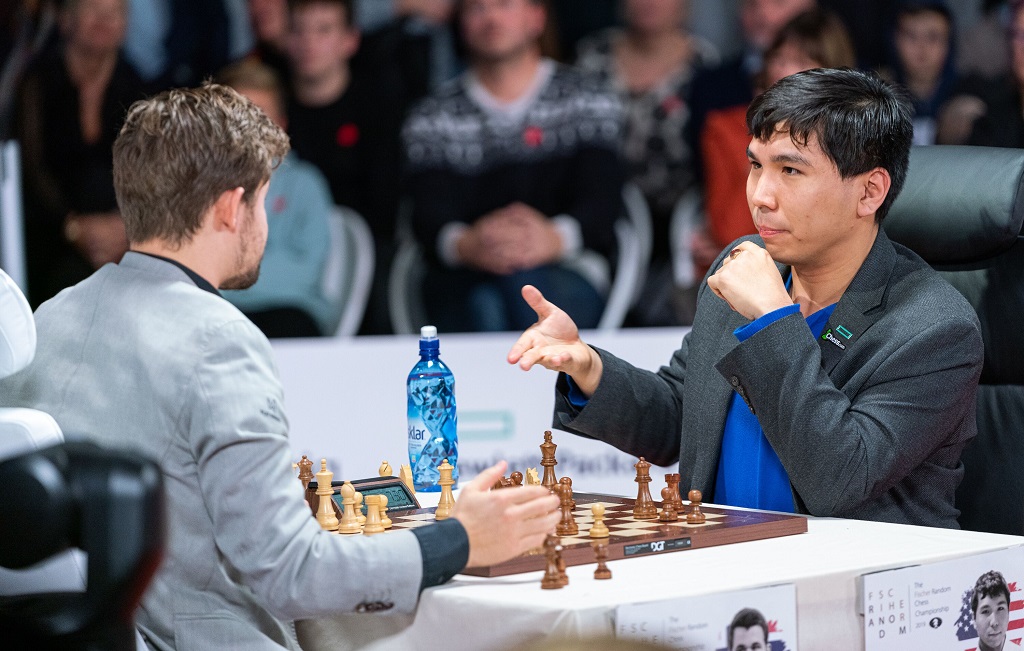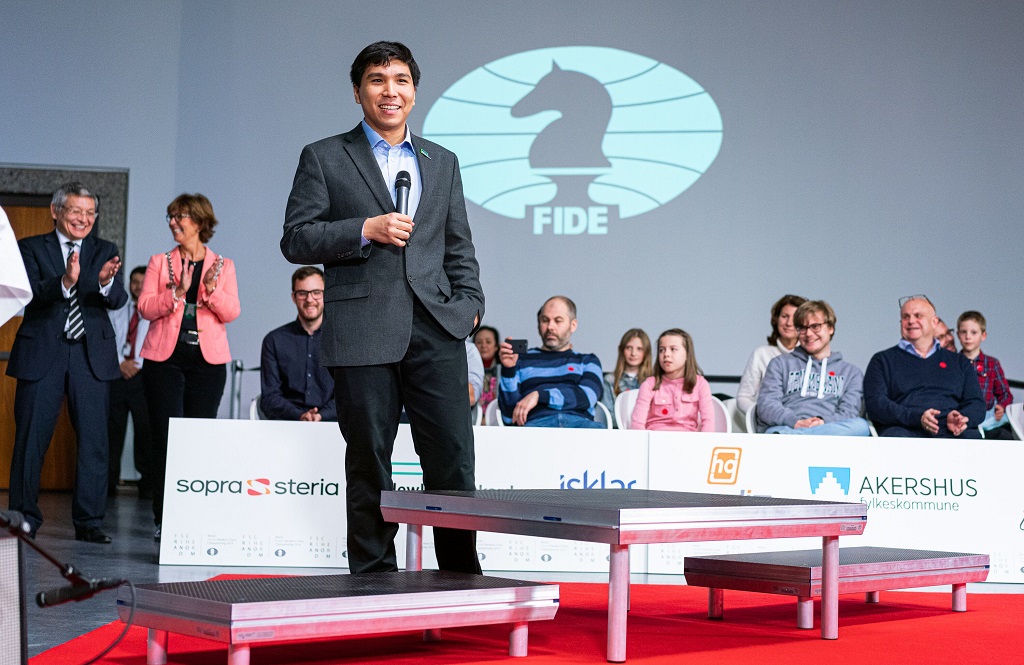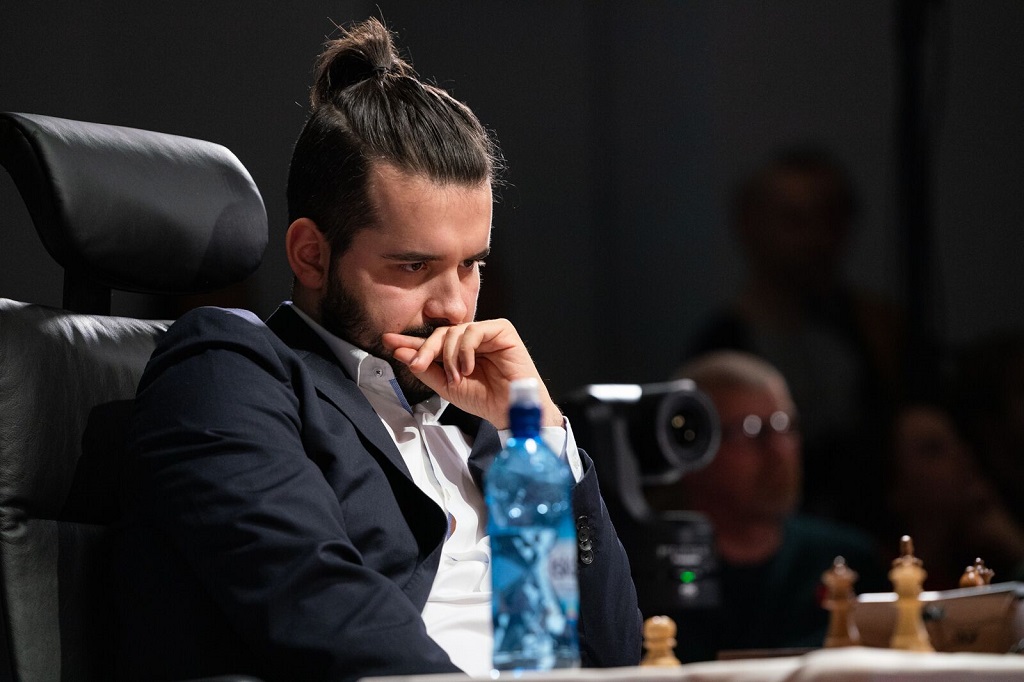


The third day of both the semis and the finals started with four 'fast rapid' games, with a time control of 15 minutes for the whole game and 2-second increments per move. A blitz phase with four 3-minute games was supposed to follow, but none of the four matches played in Norway throughout the week reached that stage, as the winning player collected 12½ points or more in the 'fast rapid' every single time.
Saturday's drawn initial position had an awkward bishop on the d-file and a chance to immediately attack a7 (or a2) after move one:
1.f4 and 1.♘b3, defending the pawn weakness on the a-file, were the obvious choices to start the game. Carlsen chose the latter in the first encounter of the day, but later found it hard to place his light-squared bishop on an active square.
The eventual champion later pointed out that Carlsen's 20.♗b1 was a critical mistake, as maintaining the bishop on the f1-a6 diagonal was necessary to help a potential attack on the kingside — especially given the fact that White needed a win to recover lost ground.
Three moves later, the computer assessed the position as winning for Black:
White's previous 23.♘a5 allowed Black to plant his own knight on the strong c5-outpost, getting a clear strategic edge. However, after 23...♞c5 24.♘c6+, So opted for 24...♚b7 instead of 24...♚a8 and permitted his famed rival to give perpetual checks from a5 and c6. The American later recounted that he was told right after the game that the engines gave him a large advantage, and declared:
I was totally shocked. I felt I was better, but I thought that +3 was too high, considering the position has equal material. That just shows how strong computers are these days.

Wesley So offering the draw | Photo: Lennart Ootes / frchess.com
Thus, the world champion was obliged to get a string of consecutive wins if he wanted to make a comeback, but by that point he was most likely discouraged by his previous play in the match. He tried to get a double-edged position with Black, only to face an unforgiving So, who got yet another strategically superior position. Moreover, Carlsen allowed his dark-squared bishop to get trapped on move 16:
By playing 16...e5 here, the Norwegian gave way to 17.g3, when his bishop has no place to go. From this point on, there was no looking back for So, who showed precise technique to convert his material advantage into the win that gave him the title. This was the final position:
It is Black to move here, but even if he plays 29...b5 White can continue with the lethal 30.♖a4+, when after 30...bxa4 31.♕a5+ ♚b8 32.♕xd8+ White's attack with the queen and the pair of knights is unstoppable.

A large audience witnessed the last day of action at the Henie Onstad Art Center in Høvikodden — Magnus Carlsen arriving | Photo: Lennart Ootes / frchess.com
Afterwards, Wesley So stressed the fact that this was a totally unexpected result for him, mentioning once and again the respect he has for his opponents. Talking about the difficulties of playing at such a high level, he pointed out that top athletes need not get very cosy even when they are doing well:
I usually get comfortable with where I am, with my play, but that's never good if you're still competing, if you're an athlete. You always need to desire to get better and to achieve more.
Referring to the format, he declared his wish to see more Fischer Random events in the future, as "it adds a very interesting flavour to the game of chess".

So was as polite as ever during his closing speech | Photo: Lennart Ootes / frchess.com

The two strongest players in the world could not stop him... | Photo: Lennart Ootes / frchess.com
The closing ceremony had to wait for the match for third place to end, as So got the title after merely two games. The wait was not long though, as Ian Nepomniachtchi secured the bronze after three 'fast rapid' encounters against Fabiano Caruana. The Russian had started the day with 7½ points. He won the first game and found a nice perpetual to draw the second, thus getting to 10½.
A win in game three was all he needed, and he got it in style, with a lethal onslaught against the white king:
37...♝xc3 was the beginning of the end for Caruana. After 38.♖e2, Black placed his bishop on a strong outpost with 38...♝d4, and the attack resumed. Resignation came six moves later, with mate-in-seven on the board:
With the black king on b6, there are no more checks for White, and there is no way to defend the immensely vulnerable c1 and c2-squares. White resigned.
For Nepomniachtchi, this was the perfect recovery after having suffered a painful loss against Wesley So in the semi-finals. The Russian expressed his frustration after that match on his Twitter account, but after his clear victory over the world number two he will certainly face the coming leg of the Grand Prix with a more positive outlook.

Ian Nepomniachtchi | Photo: Maria Emelianova / frchess.com
Download the PGN files of the games and examine them in ChessBase: Day 1, Day 2, Day 3.
| Rank | Name | Score | Rating |
|---|---|---|---|
| 1 | So, Wesley | 13½/12 | 2767 |
| 2 | Carlsen, Magnus | 2½/12 | 2876 |
| Rank | Name | Score | Rating |
|---|---|---|---|
| 1 | Nepomniachtchi, Ian | 12½/12 | 2776 |
| 2 | Caruana, Fabiano | 5½/12 | 2812 |
Commentary by Sopiko Guramishvili, Danny Rensch and Yasser Seirawan